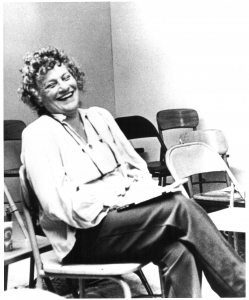
Contrapuntal Argument A, B and C
Two players and a timekeeper and a scorer.
Contrapuntal Argument A
The players begin an argument involving both of them, with both developing and unfolding his own theme. They are to talk simultaneously and without pause. The object is for each player to avoid letting the other interrupt his argument.
Scoring should be set up on the basis of how often each player is stopped; points are lost with hemming and hawing, saying yes or no, with repeats of other players lines, with stoppages of any sort, with any “dribbling of the ball” or just “treading water” and not continuing unfolding of point of view.
Contrapuntal Argument B
The players simultaneously carry on a discussion or argument in which each keeps his own point of view. Scoring should be set up on the basis of how many times each player succeeds in getting the other player to pick up on his point of view.
FOCUS: Each player tries to avoid picking up and repeating any subject matter from the other player, and also simultaneously tries to get the other player to pick up content from his point of view.
Contrapuntal Argument C
This time players keep to their own points of view as in the previous contrapuntal arguments but at the same time pick up from each other. They are to “explore and heighten” (as in the exercise with that title, p. 235) what they have received. They are to talk simultaneously. No time limit is necessary.
NOTE: (In trying to concentrate, some players work “alone/’ which forestalls the solving of the problem.)
This is another example of Contrapuntal Argument Part 1 with Dan Castellaneta and myself – Notice that while keeping our own points of view, we were actually mirroring gestures which shows that we were picking up from each other as in Argument 2 and 3.
SIDE COACHING: Talk to each other! Keep your own point of view! You’re together! Penetrate his point of view! Expand your point of view! Expand your partners point of view!
POINTS OF OBSERVATION
-
Argument as used here relates to discourse or point of view and not to debate or conflict. It is sometimes difficult for student-actors to realize that people might hold different points of view without imposing or being in conflict (and have a right to it).
-
Players must talk to each other and notat each other.
-
As in all transformation exercises, this is not to become a workout in association or inventiveness springing from a limited or prejudiced view of something. Suggest that players avoid all words that bring in subject, whether it be *%” “you,” or mention of the “subject” itself. This will prevent agreement or disagreement from sliding into mere back-and-forth chitchat.
-
When keen penetration of each other’s points of view is made and both players’ points of view expand, “I,” “you,” and “subject are brought in as part of the content rather than as a “hanging on” point, and the players transcend their points of view. An intuitive jump between players seems to take place (see Points of Observation in USING OBJECTS TO EVOLVE SCENES, p, 212),
-
If players do not solve this problem, come back to it after using TBANSFORMATION OF RELATIONSHIP. In that exercise “transforming” becomes more understandable because it is on a physical level. Interestingly enough, when CONTRAPUNTAL ARGUMENT exercises succeed, players physicalize, for it becomes impossible just to sit and verbalize. The point of view takes over the player from head to foot, and he is there, so to speak.
